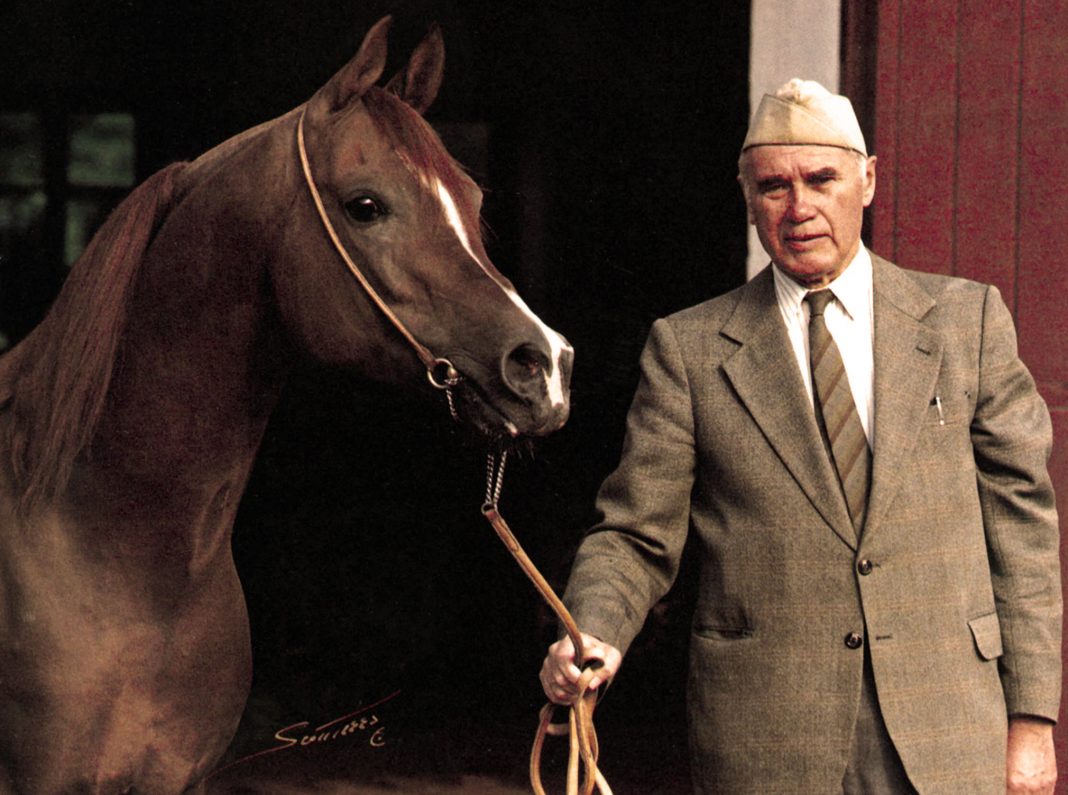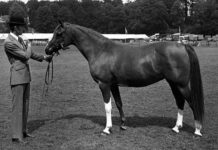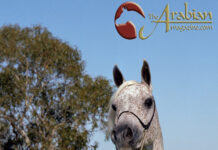In The Arabian Breeders’ Magazine Collectors’ Edition 2021, we ran an in-depth feature on the legacy Monogramm through his incredible daughters. We are serialising this feature here on TheArabianMagazine.Com over the following weeks. If you would like to buy the original magazine with this feature in full, please click on the link above.
December 2000 – the Salon du Cheval, Paris, France. The new millennium was about to be ushered in by a revolution, one that would not only transform the World Arabian Championships in its third decade of existence but would redefine the standard of excellence for the Arabian show horse worldwide and forever raise expectations of what the Arabian mare could and should be.
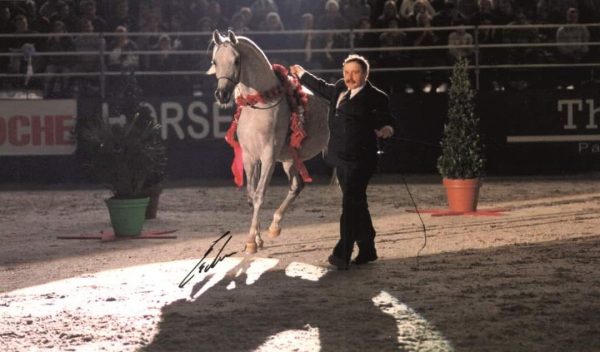
Zagrobla’s World Champion winning appearance in Paris 2000 marked the beginning of the magical influence of Monogramm. Credit Escher
The Polish State Studs, Michałów and Janów Podlaski, travelling together as Team Poland, had once again made the transcontinental journey at the onset of winter to showcase the best of their respective breeding programmes to breeders from across the globe. No strangers to success at the World Championships since the very beginning of this prestigious event, what would unfold over the course of the next three days would rewrite the historical record in epic proportions, forever elevating the fame and fortune of the Polish Arabian horse and exalting the name of one monumentally influential sire into legend – Monogramm.
Team Poland was comprised of serious contenders in three of the four divisions – fillies, mares, and stallions – with no entries forward in the colts, not uncommon for the Poles who are content to let the young males mature outside of the spotlight. The Michałów-bred horses in this millennium collection were sired primarily by foreign-born sires, all of whom had added more modern cosmopolitan appeal to the solid substantial structure and natural purposeful athleticism for which the Polish horses had been prized for decades. This masterful combination of trendy and new with tried and true proved to be indomitable with both judges and spectators alike, resulting in high scores across the board and cheers of resounding support for nearly all the Michałów-bred entries. By the time the final rose garland was sashed on Sunday afternoon, four Michałów-bred horses were adorned in red: the enchanting Emmona (ex Emilda by Pamir) as World Champion Junior Filly; the electrifying Ekstern (ex Ernestyna by Piechur) as World Champion Senior Stallion; and a rapturous pair of global show-stoppers – Zagrobla (ex Zguba by Enrilo) and Kwestura (ex Kwesta by Pesennik) – as World Champion and World Reserve Champion Mare respectively. All four of these soon-to-be legendary show horses shared the same paternal source, the American-bred Monogramm (Negatraz x Monogramma by Knippel), whose name would forever be etched into the record books for this unprecedented, and yet unrivalled, triumph at the World Championships, a first, and now aspirational achievement, for both sire and breeder.
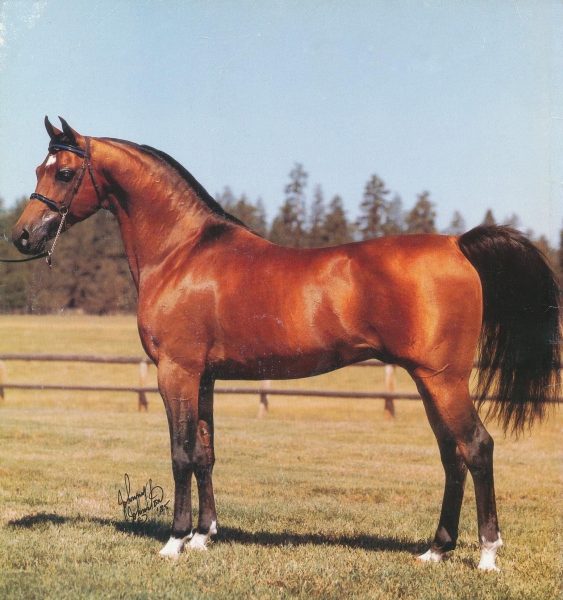
Negatraz (Bask x Negotka). Credit Johnny Johnston
Origins
Born and raised in 1985 against the epic backdrop of the Cascade Mountains in central Oregon, USA, at the world-renowned Patterson Arabians, Monogramm was created by combining the genetics of two of the most important and influential breeding programmes of the 20th century, those of Poland and Russia. His well-respected sire Negatraz, the heart and soul of the Patterson Arabians programme, was the product of Polish-born parents, the Albigowa-bred breed pillar Bask (Witraz x Bałałajka by Amurath Sahib), and the beautiful and athletic Janów Podlaski-bred Negotka (Negatiw x Bigotka by Arcus). Monogramm’s dam, from which his now household-status namesake was derived, was the Tersk-bred uber athlete Monogramma (Knippel x Monopolia by Priboj), a record-holder on the Russian racecourse, an elite matron, and a direct maternal granddaughter of the most precious Russian matron Mammona (Ofir x Krucica by Farys II), whose legend is buoyed by her heroic 2,500km journey as a foal at foot when confiscated by the Soviets from Janów Podlaski at the outset of World War II.
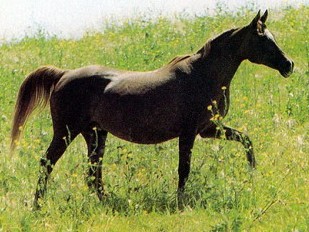
Monogramma (Knippel x Monopolia)
Monogramm was unlike either of his esteemed parents in overall phenotype, but more of a unique individual with his own distinct type and collection of abundantly appealing characteristics blending the best of his illustrious heritage, a definitive look that was soon to be replicated with pleasing predictability to the resounding benefit of the breed.
Purchased as a yearling by Bill and Meredith Bishop of Bishop Lane Farm in Northern California, Monogramm would soon find fame in the show-ring with his definitive phenotype, bolstered by his trademark type, charisma, tail carriage, and trot. He will forever be remembered for his incomparable show-ring entrances, forehand aloft, eyes wide and alert, ears pricked forward, nostrils flaring, tail at full mast, covering the ground with impressive power, animation, and suspension at the trot without ever breaking stride, exuding utterly captivating presence, charisma, and confidence to the thunderous approval of everyone fortunate to be in attendance.
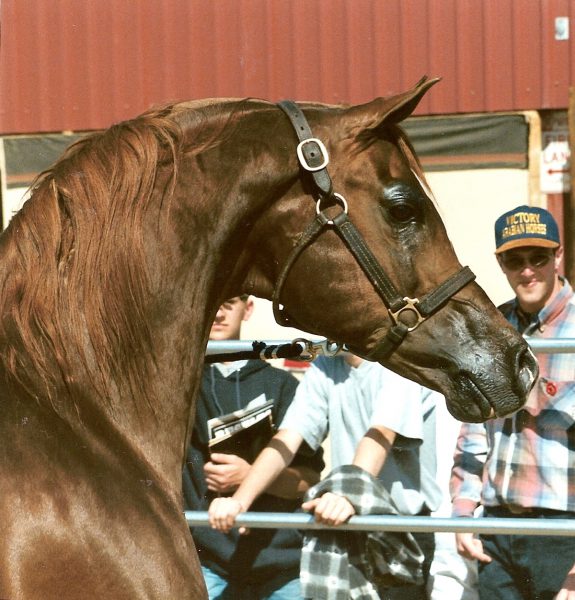
Monogramm
It was during one such show-ring performance, in the futurity stallion class at the US National Championships in 1988, that Monogramm caught the serious attention of Polish breeders, who had long sought a quality source of Bask blood to incorporate into their modern breeding programme. The unique combination of type, trot, elegance, and refinement, fortified by the presence of both Bask and Mammona in the second generation of his pedigree, were a revelation to Michałów Director Ignacy Jaworowski and Polish Arabian Horse Specialist Izabella Zawadzka, both of whom were forever transformed by Monogramm’s presentation in the show-ring that day, and were as unequivocally convinced that he was an ideal choice for the mares of Poland.
A visit to Michałów for the Bishop’s was finally organised four years later to meet the legendary mares of Poland themselves and to discuss the possibilities of a multiple-year lease of Monogramm, the result of which would irrevocably alter the destiny of both owners and breeders, as well as the enduring legacy on Monogramm and his prolific positive impact on the future of the Arabian breed worldwide.
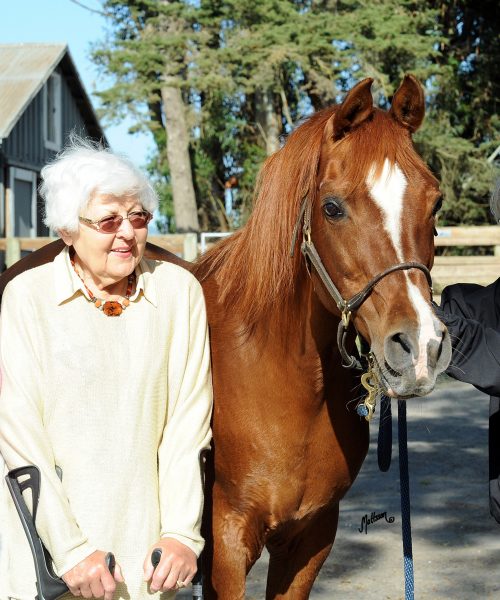
Izabella Zawadzka with Monogramm in later years. Credit Fotograf Mattsson
Poland transformed
I was privileged to make the 2,700km round trip journey to transport Monogramm to Michałów upon his European arrival in December of 1993. An epic expedition in the height of comfort for Poland at the time – a Mitsubishi Pajero towing a standard, no-frills, straight-load, two-horse Böckmann trailer – Monogramm was an ideal passenger on the more than 24-hour journey across the continent, which included innumerable repeats of a black-market Queen’s Greatest Hits cassette tape and a lengthy stop at the former East German border with its typical bureaucratic complications and incomprehensible delays.
We arrived back to the sleepy village of Michałów in the early evening on an already dark, blustery, and chilly winter night to much anticipation as only Director Jaworowski, and then Breeding Manager Jerzy Białobok, who was a member of the arrival caravan, had seen Monogramm in the flesh. Jerzy’s wife, Deputy Director Urszula Białobok, was the most trepidatious of the new stallion’s arrival, as Poland had used a well-bred maternal half-brother years earlier with very little success. She had gathered with Director Jaworowski’s wife, Maria, and nearly all of the Michałów grooms to witness this momentous occasion, headlights illuminating the paddock adjacent to his quarantine stable where the newest chief sire was backed out of the trailer. The tears that flowed from her eyes that evening were those of joy and astonishment, as Monogramm emerged from more than three days in transit as commanding, effervescent and supremely confident as he would prove to be on a daily basis, his perfectly designed head held high, those remarkable ears alert, his luminous eyes blinking in the bright direct light, calling out to his new harem of mares with a deep resonant whinny as if to announce his triumphant arrival. Though expectations were unquestionably high, little did we all realise the monumental leap forward upon which Michałów and the Polish Arabian breeding programme, and subsequently the Arabian breed, was about to embark.
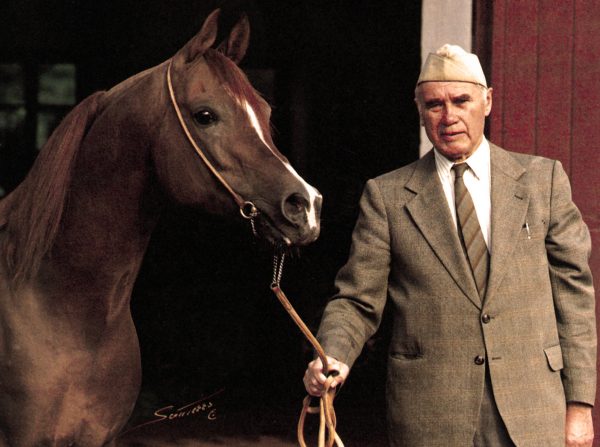
Director Jaworowski with Monogramm. Credit Scott Trees (and cover photo)
It was long the practice of the Polish breeders at the State Studs to cover large groups of mares in a single season by the same sire, an uncompromising litmus test of a stallion’s genetic potential. This ‘make or break’ policy was tested to the extreme in 1993 when Monogramm successfully covered 49 mares in a single season, a record for any stallion at a solitary stud. With more than half the anticipated 1994 foal crop sired by Monogramm, both anxiety levels and expectations alike were palpably high when the first bundles of joy arrived in January. Any apprehension, however, soon gave way to elation, as foal after foal, each seemingly more exciting and promising than the last, were born in rapid succession through early June. So successful were the results of the 1994 foal crop that even more mares were bred that same season, with many of the most auspicious matings repeated for pairs of full siblings that have since earned their honoured place in the annals of the Arabian breed. Prior to his departure from Poland after his second full season in residence as chief sire, Director Jaworowski successfully renegotiated the lease agreement to include future foals conceived from semen frozen onsite, the result of which were seventeen more precious foals through 1998, extending the Monogramm influence to 113 Michałów-bred foals across five seasons.
To have lived and worked at Michałów as the Monogramm foals arrived and matured was a profound privilege, the gravity of which I could not fully appreciate at the time. We were providential witnesses to the transformation of one of the most successful and universally admired Arabian breeding programmes in the world, Michałów Stud, from the time ‘before-Monogramm’ to the resplendent time ‘post-Monogramm’. The already world-class collection of horses was now teeming with overly exuberant Monogramm clones, utterly alluring little personalities that inspired the imagination, heads and tails aloft, snorting and blowing with astounding confidence and poise, gorgeous chiselled faces, large luminous eyes, smooth, well-balanced silhouettes with effortless athleticism, powerful and animated, with undeniable ‘I-dare-you-to-look-away’ charisma and presence, refinement and aristocratic quality in indomitable abundance.
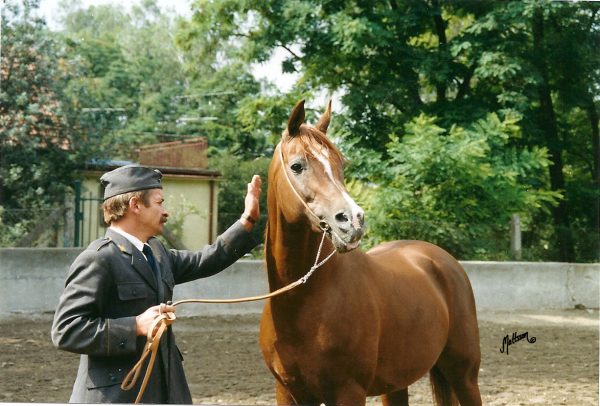
Monogramm at Michałów State Stud, Poland. Credit Fotograf Mattsson
Monogramm’s residency as chief sire just happened to coincide with the presence of several of the most prolific and influential matrons in Michałów breeding history when the stud was arguably at its zenith in terms of genetic potential. Among these matrons were prized collections of Palas (Aswan x Panel), Probat (Pohaniec x Borexia), Eukaliptus (Bandos x Eunice), Penitent (Partner x Penza), Pamir (Probat x Parma), Pepton (Bandos x Pemba), Piechur (Banat x Pierzeja) and Europejczyk (El Paso x Europa) daughters, as well as mares sired by lesser-known stallions such as Enrilo (Probat x Emisja), Pesennik (Kumir x Pesnia), Fanatyk (Aloes x Fatima), Eternit (Bandos x Etna), Set (Etap x Sekwana), Tallin (Nabeg x Talantlivaia) and Gadir (Saudi x Garda). From these meritorious matrons, Monogramm would create his own dynasty of daughters, the collection of which would eclipse all those who had come before, and, so far, have been created since.
Like many a chief sire before him, Monogramm was able to contribute his trademark attributes – an exquisitely designed head, a long, lean, highly carried neck with a clean elastic throat, undeniable type, ultra-refinement and aristocratic quality, exuberant tail carriage, utterly captivating charisma and that signature trot, animated and powerful with gravity-defying loft and suspension – to the genetic pool in Poland without fundamentally altering the quintessential style and appeal of the Polish Arabian horse in subsequent generations.
Monogramm did, however, possess the uncanny ability to enhance the phenotype of nearly every mare to which he was bred with remarkable reliability and an unmistakable stamp, as if monogramming each of his appealing progeny as incontrovertibly his own. From the cherished international champions descending from the most celebrated dam families to the indispensable broodmares that represented many of the smaller, yet no less important, dam lines that had been carefully stewarded by the Poles for decades, Monogramm was mated with representatives from every single dam family at Michałów during his tenure, a comprehensive master stroke of breeding bravado and genius that created a consummate collection of both standard-setting breed icons that have since illuminated elite show-rings all around the world, and, most essentially, invaluable breeding horses that continue to raise the standard of excellence for the global Arabian breed.
For Part II of this in-depth feature, click here.
First printed in The Arabian Breeders’ Magazine Collectors’ Edition 2021.
For more features from The Arabian Breeders’ Magazine, click here.


